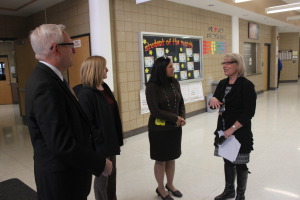Minnesota Department of Education Commissioner Brenda Cassellius made her way through the halls of two St. Michael-Albertville School District buildings Monday, hearing about the district’s successes and challenges during a three-hour visit to the area.

St. Michael-Albertville School District Superintendent James Behle and Maria Vincent of the Minnesota Department of Education look on as State Ed Commissioner Brenda Cassellius and Fieldstone Elementary Principal Jeanatte Aanerud discuss elementary education programs in the school.
Dr. James Behle, superintendent of STMA schools, led the commissioner on a walk through St. Michael-Albertville High School first, showing the state’s education leader the state-of-the-art facility, including its expansive area dedicated to technology and trades. He also profiled the high school’s award-winning literacy and Advanced Placement programs, with the help of STMA High School administrators and staff.
“One of the things we’re very proud of is the opportunity we provide as a district with technical education, and the amount we’ve dedicated to that programming,” Behle said. Cassellius was impressed with the resources at the high school.
“The idea is to prepare kids for a future with technology, and this is certainly part of that,” she said of the trades area. “There are career fields in this area that are just exploding with potential.”
At Fieldstone, the focus centered around the district’s use of state and federal money to grow literacy programs at the elementary school level, and the resources necessary to close the achievement gap, a statewide focus. Cassellius, sensing the district’s need to “get creative” due to funding inequities, fostered some ideas for administrators, such as Fieldstone Principal Jeanette Aanerud, to share ideas with leaders from other districts.
“As I go around to schools across the state, that’s something I really enjoy doing is sharing the best practices, kind of cross-pollinating those ideas. There are things that they do well here [in St. Michael-Albertville] that similar districts in size and scope can use, and of course I’ve picked up ideas from other districts that I can share with Dr. Behle and his staff. It’s one of the things I really like about coming out to these areas is finding out what everyone is doing well and sharing that throughout the state,” Cassellius said.
When it comes to funding inequity – STMA ranks among the bottom 2 percent in terms of funding statewide – Cassellius pointed to strides made over the last biennium to provide districts with higher per-pupil payments, as well as a direction of the Legislature to not repeat the mistake of “borrowing money from the schools” in the near future.
“We wanted to show her that the district needs dollars to continue those programs that have been successful for us, and have a conversation about the opportunity that provides our students,” Behle said.
As the state heads into another biennium with a projected surplus, she’s hoping additional money steered toward education costs can be used to narrow the gaps in funding districts.
“We’ve been able to reduce that disparity, somewhat, over the last two years. More needs to be done. We need to continue to provide uniformed opportunity for all the kids in our state,” she said.